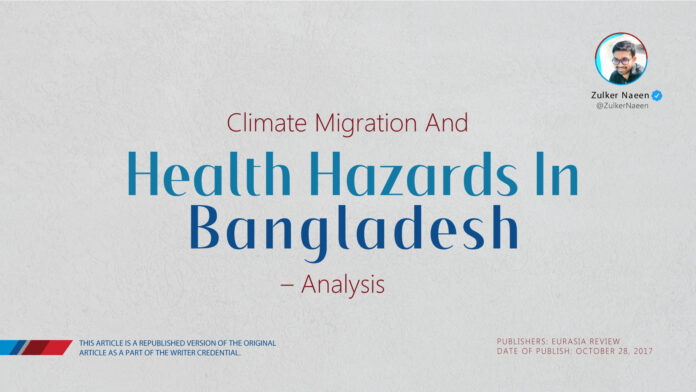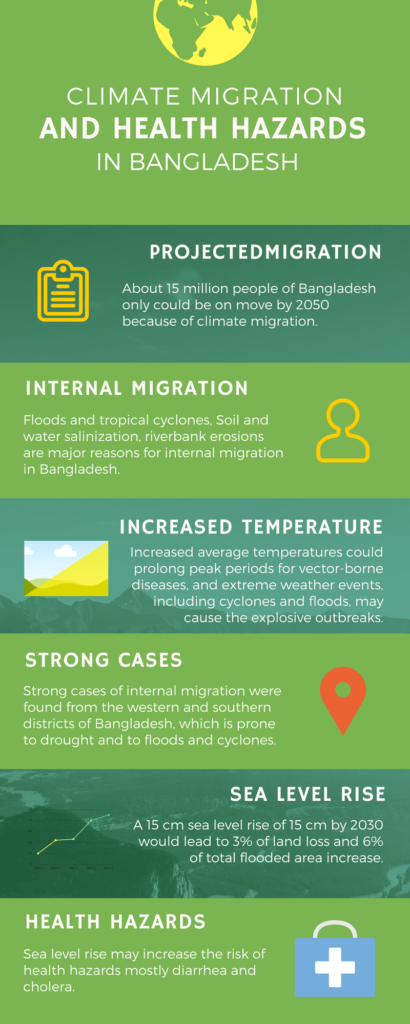Most parts of South Asia are both highly populated and highly exposed to the impacts of climate change. Bangladesh is one of those areas that receive the utmost attention because of climate risks and climate migration. It is likely about 15 million people from Bangladesh only could be on the move by 2050 because of climate migration.
Publishers: Eurasia Review
Date of Publish October 28, 2017
Climate Migration And Health Hazards In Bangladesh – Analysis
Most parts of South Asia are both highly populated and highly exposed to the impacts of climate change. Bangladesh is one of those areas that receive the utmost attention because of climate risks and climate migration. It is likely about 15 million people from Bangladesh only could be on the move by 2050 because of climate migration.
The Ganges–Brahmaputra Delta has identified as the hot spots of climate change in this region. It is a particularly low-lying and therefore vulnerable coastal zone.
Internal migration is happening in Bangladesh; large populations are already being displaced or have decided to migrate due to cyclones and riverbank erosion. We found migration from the southern region Satkhira, Kuakata, Shoronkhola, and Potuakhali.
Climate change is likely to increase migration out of the western and southern districts of Bangladesh. Those districts are prone to drought, floods, and cyclones.
Floods and tropical storms are reasons for internal migration in Bangladesh. There is also evidence of abrupt, short-range population movement can, at least indirectly, also influence longer-range migration. Therefore, the effect of climatic drivers has a drastic impact on livelihoods in Bangladesh.
Soil and water salinization and riverbank erosions are some of the other causes of migration in Bangladesh. It put an additional strain on people’s livelihoods and physical health.
Among the drivers of migration are also tropical cyclones in the Bay of Bengal, which could increase in intensity by 2050 due to climate change under a business-as-usual scenario.
In a 4°C world, a sea-level rise of 62 cm by 2080 could result in a loss of 13% of Bangladesh’s coastal land area and lead to flooding of 20% more land than currently.
However, a 15 cm sea level rise by 2030 would lead to 3% of land loss and 6% of total flooded area increase. Sea level rise will likely increase the risk of health hazards, mostly diarrhoea and cholera. Cholera germs find a more favourable habitat and are spreading in the coastal area.
Vibrio cholera is the causing microbe of cholera. It survives longer with the salinity level of the water ranging from 2.5 ppt to 30 ppt. Thus, sea-level rise, by increasing flood risk, increases the risk of cholera outbreak too. Increasing salinity levels also lead to increased incidences of hypertension in the coastal areas. It is a significant problem for expecting women and can even cause involuntary fetus abortion.
Increased average temperatures could prolong peak periods for vector-borne diseases, and extreme weather events, including cyclones and floods, may cause explosive outbreaks.
Internal migration can lead to increases in diseases, poor nutritional status resulting from overcrowding, a lack of safe water, food, and shelter.
In Bangladesh, like other effects on health, population displacement may create conditions conducive to outbreaks of infectious diseases, further increasing the potential for transmission of vector-borne disease and hindering the future control of a disease.
Climate migration in Bangladesh has no clear jurisdiction so far; however, its progress will be the next challenge for the government. Still, it is unclear how the government will feed, house or find enough clean water for vast numbers of climate refugees in a country of 163 million people crammed into an area merely 56,977 mi² area.
Bangladesh should change the cultivation practices to boost food security, plant large areas of forest in flood-prone areas to cope with the emerging problems.
However, climate change now poses a significant risk to human health, even if mitigation actions have taken globally.
Adaptation measures will be needed in the coming decades to buffer some of the significant effects on human health.











